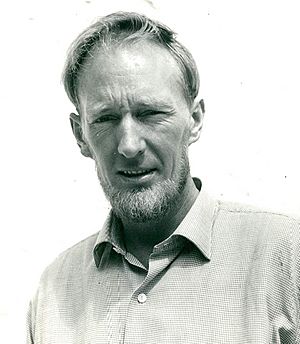Hamish MacInnes facts for kids
Quick facts for kids
Hamish MacInnes
|
|
|---|---|
 |
|
| Born | 7 July 1930 Gatehouse of Fleet, Galloway, Scotland
|
| Died | 22 November 2020 (aged 90) Glen Coe, Scotland
|
| Occupation | Mountaineer |
| Known for | Invention of all metal ice-axe and MacInnes stretcher, a light-weight foldable alloy stretcher |
Hamish MacInnes (7 July 1930 – 22 November 2020) was a famous Scottish mountaineer, explorer, and mountain rescuer. He also wrote many books. People often called him the "father of modern mountain rescue in Scotland".
Hamish was known for inventing the first all-metal ice-axe. He also created a special lightweight, folding stretcher called the MacInnes stretcher. This stretcher is used all over the world for mountain and helicopter rescues. He even helped with safety on big movies like Monty Python and the Holy Grail and The Eiger Sanction. His 1972 book, International Mountain Rescue Handbook, is still used today as a guide for mountain rescue teams.
Contents
Early life and first climbs
Hamish MacInnes was born in Gatehouse of Fleet, Scotland, on 7 July 1930. He was the youngest of five children. He became interested in climbing at a very young age. By the time he was 16, he had already climbed the famous Matterhorn mountain. He even built his own car from scratch when he was 17!
In 1953, when Hamish was 23, he tried to climb Mount Everest with his friend John Crabbe Cunningham. They almost made it to the top. Soon after, Edmund Hillary and Tenzing Norgay became the first to successfully climb the mountain.
Hamish also made the first winter climb of Crowberry Ridge Direct and Raven's Gully in the Scottish Highlands. He did this with another famous climber, Chris Bonington, in 1953. He even climbed the Aiguille du Dru in the French Alps after hitting his head on a rock.
Innovations in mountaineering
Hamish MacInnes was very creative and invented many new things for climbing. He designed the first ice axe made entirely of metal. He also helped introduce shorter ice axes and hammers for climbing in Scottish winters.
He explored the cliffs of Glen Coe for winter climbing and led the area's mountain rescue team starting in 1961. He helped create modern mountain rescue in Scotland. In 1965, he started the Search and Rescue Dog Association with his wife. He also set up the Scottish Avalanche Information Service in 1988.
His most famous invention is the MacInnes stretcher. This special stretcher is light and can fold up. It is used by rescue teams around the world.
Everest expeditions and other adventures
In 1972, Hamish was part of a team that tried to climb the southwest face of Everest. They did not reach the top because of bad weather. In 1975, he was a deputy leader on another Everest expedition led by Chris Bonington. Hamish was in charge of designing equipment for this trip. However, he was caught in an avalanche high on the mountain and had to stop climbing.
He later climbed the challenging Mount Roraima, a mountain in South America. Hamish also made the first winter crossing of the Cuillin Ridge on the Isle of Skye with his friend Tom Patey.
Working on films
Hamish MacInnes worked on several movies as a climber, stunt double, and safety officer. He helped with the 1975 film The Eiger Sanction and the 1986 film The Mission.
He was also part of the team for the 1975 film Monty Python and the Holy Grail. He was a climbing expert for the movie and even built the film's "bridge of death." He became good friends with the actor Michael Palin.
Books and recognition
Hamish wrote many books about mountaineering. His book International Mountain Rescue Handbook (1972) is a very important guide for mountain rescue teams everywhere. He also wrote Call-out: A climber's tales of mountain rescue in Scotland (1973), which shares his experiences leading the Glencoe Rescue team.
He was sometimes called "Old Fox of Glencoe" or "The Fox of Glencoe" by other climbers.
In 1994, Hamish left his role as leader of the Glencoe Mountain Rescue team. This was because his team decided to let the BBC make a documentary about their work. However, the team later changed their minds, and he returned as leader.
Awards and honours
Hamish MacInnes received many awards for his work.
- In 1962, he was given a British Empire Medal.
- In 1979, he was made an Officer of the Order of the British Empire (OBE) for his services to mountaineering and mountain rescue in Scotland.
- He received honorary doctorates from several universities.
- In 2007, he became an honorary fellow of the Royal Scottish Geographical Society.
- He was added to the Scottish Sports Hall of Fame in 2003.
- In 2008, he received the Scottish Award for Excellence in Mountain Culture.
In 2018, a documentary film called Final Ascent: The Legend of Hamish MacInnes was made for BBC Scotland. His friend Michael Palin introduced the film. It told the story of Hamish's life and how he used his old photos and books to remember his adventures.
Later life
Hamish MacInnes lived in Glen Coe for many years.
In 2014, Hamish became very confused due to an undiagnosed infection. He was cared for in a hospital. He tried to escape several times, even climbing onto the hospital roof! After about five years, the infection was found and treated. Hamish got better, but he had lost some memories of his climbing career. He worked to remember them by reading his own books and accounts.
He passed away on 22 November 2020, at the age of 90, at his home in Glen Coe. Many people said that no one did more than Hamish MacInnes to help create the emergency rescue teams that keep climbers safe.
See also
 In Spanish: Hamish MacInnes para niños
In Spanish: Hamish MacInnes para niños

